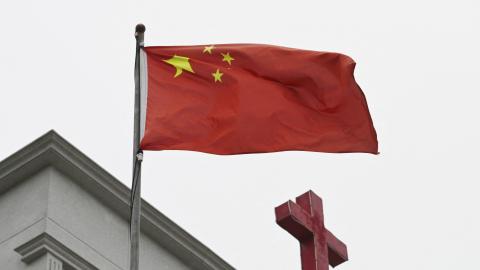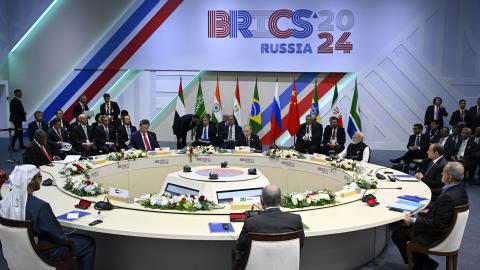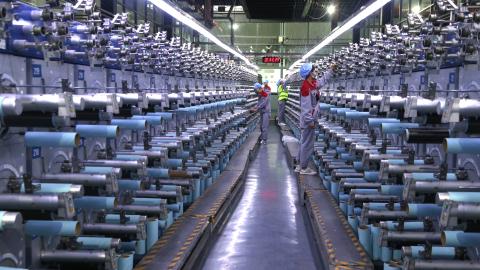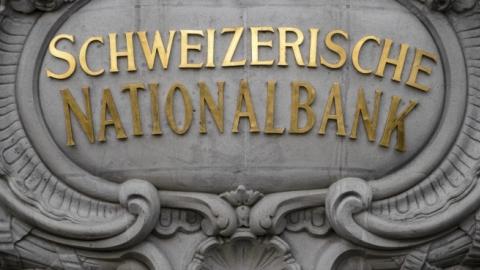In Switzerland, dramatic gestures of political defiance are often times a complicated business, simultaneously reflecting both a deep tradition of nationalist romanticism and an equally deep and hard-eyed realism. When General Henri Guisan delivered his famous Rütli meadow Réduit National address to the entire Swiss officer corps in July 1940—promising perpetual resistance to any future German invasion—the political elite in Zurich were already negotiating an economic treaty with Berlin in order to align Swiss interests with a likely Nazi-dominated Europe.
And a similar dualism is now apparent in the monetary policy announcements that have just produced Switzerland’s currency shock.
First, there is the romanticism. Switzerland has dramatically exited the global 2 percent inflation standard, smashing the previous floor on the franc’s exchange rate against the euro, and doing so with no advance notice to International Monetary Fund managing director Christine Lagarde—and barely a week before European Central Bank president Mario Draghi’s anticipated rollout of a major ECB quantitative easing (QE) plan on January 22. In effect, the Swiss National Bank (SNB) and Zurich’s political leadership decided that even a near-term period of falling prices and associated market disruptions would be preferable to continued Swiss shadow membership in a euro-zone being inexorably dragged by Draghi and his allies into a likely monetary Dark Age of chronic financial crisis and recession. For a precedent, financial historians can look back to the early 1970s, when Switzerland (joined by West Germany) declined to follow the Richard Nixon/Arthur Burns-era Federal Reserve Bank off the diving board into deep-end inflation, repudiated the Bretton Woods system, introduced monetarist regimes, and allowed their currencies to float upwards.
And then there is the realism. For quite some time now, and long before last week, Zurich—and every other interested observer—has been aware that the ECB is planning to launch a significant QE program for the euro on January 22. That expectation was already fuelling a huge flow of funds into Switzerland—on the assumption that the SNB would not engage in further QE itself and that the Swiss franc might therefore jump in value, especially if the exchange-rate floor were actually suspended. In order to maintain that floor, the SNB would have been required to make further, massive purchases of foreign currencies including the euro. But its last such adventure (during 2010-12) resulted in painful financial losses, a ferocious domestic political backlash led by Switzerland’s rightist People’s Party, and a national referendum in the fall of 2014 which, though ultimately unsuccessful, would have seriously restricted SNB’s future authority and latitude.
Much of Switzerland’s foreign exchange reserves are now apparently invested in non-euro currencies, including (especially) the U.S. dollar. So, given the recent appreciation and relative strength of the dollar, the Swiss might now float the franc—even were it to settle near parity against the euro—at considerably reduced risk of further domestic political embarrassment or exchange-rate loss or general economic pain. Just to make sure, the SNB has resolved to outdo the ECB in driving money-market rates into sub-zero territory (towards minus-1-percent per annum). Who knows? Maybe in a few years the combined package will again be producing inflation consistent with a global 1-2 percent per annum target! And maybe everyone in Washington and Brussels can be mollified in the meantime if Switzerland continues to cooperate with the EU and G-20 in the dismantling of its own bank-secrecy regulations!
Readers of this article are free to choose whichever interpretation of these events they prefer. My own preference—because I believe it better fits the facts—is for the realist version. But I would not dismiss the romantic alternative as entirely irrelevant. Romanticism is not infrequently a powerful political dynamic.
In any case, and either way, “Swiss defiance” and the “free franc” are certain to tarnish Mario Draghi’s January 22 ECB QE announcement, giving it a sordid allure. And in Germany, where Draghi’s plans are widely feared and loathed among ordinary citizens, Switzerland’s gesture will seem like a ray of light and hopeful model in an otherwise sombre picture. German romantics may even begin fantasizing about their own future exit from European Monetary Union and global currency-policy madness—and a return to the glory years of the Emminger Bundesbank and the hard Deutsche mark. There is already an anti-euro party (Alternative für Deutschland or “AfD”) in Germany poised to take advantage of such sentiment (and populist anti-immigration fervor to boot). Euro-hostile elements exist even within Chancellor Angela Merkel’s governing CDU party, and disgruntlement with the Bundesbank and the German establishment generally—for their failure to insulate the country from the hangover effects of the continent’s extended monetary bender—crosses all partisan boundaries.
The United States may have launched the global 2 percent inflation standard (in July 1996, when a now-infamous Federal Open Market Committee meeting endorsed Janet Yellen’s call for low inflation—rather than price stability—as the long-run goal of Federal Reserve Bank policy). But it was a paragon of the German establishment, ex-Bundesbank board member Otmar Issing, who did more than anyone else—while serving as ECB chief economist from 1998-2006—to shackle Europe with the same chains. It could not have come at a worse time. Accelerating productivity growth (resulting from epiphenomena like the information-technology revolution and globalization) were putting downward pressure on prices and wages across many sectors of the European economy. But that was not a problem demanding a solution. It was perfectly benign.
Advocates of artificially low central-bank interest rates—proponents of higher inflation, in effect—commonly warn than any decline in prices presents a “deflationary danger.” Not so. In a world of ideal monetary stability prices would remain more-or-less constant over the very long-run, but there would be a natural rhythm of prices over short- and medium-term periods determined by the variable pace of productivity growth, the business cycle, the evolving nature of technological change, and any number of other factors. Sometimes prices go up. Sometimes prices go down. They tend to go down—along with wages—during recessionary episodes. And there is a not-unreasonable expectation, among both consumers and producers, that they will tend to rise again in the subsequent economic upturn. It is precisely this anticipated pro-cyclical pattern of prices that causes businesses and households to bring spending forward during a recession—which is how the market’s invisible hand stabilized economies for generations under the gold standard, for example.
Attempts by the Fed and ECB to over-ride this natural rhythm have involved heavy manipulation of interest rates, below their natural levels, a strategy that paradoxically all but guarantees exactly the kind of chaotic market volatility its designers are hoping to avoid. At very low interest rates, attractive returns on “ordinary” and “safe” investments become next to impossible, and borrowing for dangerously leveraged speculative investments in this year’s “hot” market sector becomes next to irresistible. In the late 1990s, high productivity growth in the midst of the IT revolution should have brought prices gradually down. Instead, under the easy-money and “low-inflation” policies of the Greenspan Fed, we got the IT bubble—and its catastrophic, predictable bust. The same thing happened in Europe during the early-mid 2000s when an ECB battle against “threatened deflation” —once again, ultra-easy monetary policy in pursuit of the 2 percent inflation Holy Grail—produced the great sovereign-debt and real-estate market bubble and bust from which Europe is still struggling (unsuccessfully) to recover. And the same thing is happening right now (as I have argued elsewhere in oil and other commodity markets.
Yes, the previous and current Bundesbank chiefs (Axel Weber and Jens Weidmann respectively) have both objected to the ECB’s growing transformation into a transfer agency: taking surplus funds from financially strong countries, principally Germany, and lending them into weaker countries to prop up tottering banks and national treasuries, complete with an implicit default guarantee courtesy of the German taxpayer. Yet the Bundesbank chiefs have allowed themselves to get fixated on these profit-and-loss-account questions, the “trees,” rather than remaining focused on the much more important and consequential “forest”-level issue of monetary stability—and the degree to which ECB policies have worked to erode it.
The great pity of European Monetary Union is that it has been characterized by serious monetary instability since its very inception. The euro has not become a continent-wide Deutsche mark, as German citizens were originally promised. Instead, almost from the start, the ECB has finely copied every mistake of the Federal Reserve. And it is now proposing to copy another one: this week, by all accounts, the ECB will join the Fed’s “war against deflation” using a wide-range of similarly non-conventional tools and hope-for-the-best experimentation. Bundesbank officials may privately grumble. But there is little indication that they will take serious steps to reverse their slow and steady retreat on essential principles of monetary stability. Inflation targets should be met gradually, they say; certain unconventional policies may be temporarily acceptable so long as German taxpayers aren’t left solely on the hook. This is all too tame and misses the big picture.
That picture now includes a wide range of global asset markets already deeply infected by price inflation. What are the implications of the Swiss shock for the near and medium course of this disease?
A first point is that the shock inflicted huge financial loss on carry traders in the franc. The fantastic initial rise of the franc after the SNB announcement revealed the extent to which carry traders had been funding themselves (in the apparently super-low long-term Swiss interest-rate markets) on the assumption that Switzerland’s exchange-rate floor was sacrosanct. That floor disappeared, those traders then made a mad scramble for the exits, and currency-market chaos predictably ensued. Is there a lesson here for all those carry trades built on super-low Japanese interest-rate loans? Could the Japanese political and monetary elite also at some point decide that enough is enough—that they too might better exit the global 2 percent inflation standard, rather than continuing to follow Washington and Frankfurt in their financially destabilizing fantasy fight against deflation? True, no such prospect seems imminent. But who can be sure—especially about anything involving Japan’s famously non-transparent and unbalanced political system? Yen depreciation and inflation are widely and deeply unpopular in Japan. A year from now, if the Japanese economy has entered a fairly strong recovery but inflation remains below 1 percent, will the Bank of Japan have the political support necessary for another round of quantitative easing?
A second point is the knock-on effects of continental Europe’s sub-zero rates, now most deeply negative in Switzerland. Surely in the face of this new reality—0 percent on 10-year Swiss government bonds, 0.45 percent on 10-year German government bonds, significantly negative rates on euro and Swiss money-market deposits, and U.S. economic growth threatened by weakness as the oil boom turns to bust—the attractions of the yellow metal increase. Maybe the next big U.S. monetary move will be … more QE! Yes, the floating franc could provide some defensive properties for investors. But how reliable will that defence prove to be if the SNB itself is engaged in unprecedented experimentation with sub-zero rates, and if the franc begins to demand a significant safe-haven premium against other currencies?
Finally, Zurich’s smashed floor on the franc/euro exchange rate could prove to be a wake-up call to those many global investors who have been happily sunning themselves in a wide range of overheated market sectors where prices have been inflated by debt-leveraged, better-than-Fed-rate-hungry buyers. Maybe they will be jolted from their reveries and recover some long-repressed memory of the hard Swiss franc era. And maybe that memory will get them started thinking whether they, too, a whole world full of investors, should follow Zurich for the exits before the crowded trades and asset-bubble markets fall apart for good.


















